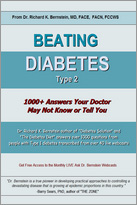Vomiting, nausea, and diarrhea are most commonly caused by bacterial or viral infections sometimes associated with flu-like illness. An essential part of treatment is to stop eating. Since you can certainly survive a few days without eating, this should pose no problem. But if you’re not eating, it makes sense to ask what dose of insulin or ISA you should take.
Adjusting Your Diabetes Medication
If you’re on one of the medication regimens described in this book, the answer is simple: you take the amount and type of medication that you’d normally take to cover the basal, or fasting, state and skip any doses that are intended to cover meals. If, for example, you ordinarily take detemir or glargine as basal insulin upon arising and at bedtime, and regular or lispro (or aspart or glulisine) insulin before meals, you’d continue the basal insulin and skip the preprandial regular or lispro for those meals you won’t be eating. Similarly, if you take an ISA on arising and/or at bedtime for the fasting state, and again to cover meals, you skip the doses for those meals that you do not plan to eat.
In both of the above cases, it’s essential that the medications used for the fasting state continue at their full doses. This is in direct contradiction to traditional “sick day” treatment, but it’s a major reason why patients who carefully follow our regimens should not develop DKA or hyperosmolar coma when they are ill.
Of course, if you’re vomiting, you won’t be able to keep down oral medication and this poses yet another problem.
Remember, because infection and dehydration may each cause blood sugar to increase, you may need additional coverage for any blood sugar elevation. Such additional coverage should usually take the form of lispro insulin. This is one of the reasons that we advocate the training of all diabetics in the techniques of insulin injection—even those who, when not sick, can be controlled by just diet and ISAs. Using insulin when you’re sick may be especially important for you, because it helps to relieve the added burden on beta cells that leads to burnout. This is but one of the reasons it’s mandatory that you contact your physician immediately when you feel ill. He or she should be able to tell you how much coverage with lispro will be necessary, and when to take it. The protocol for such coverage is discussed on pages 301–304, but because of its importance, it bears repeating again briefly:
- Measure blood sugars on arising and every 5 hours thereafter.
- Inject enough lispro at these times to bring your blood sugars down to your target value. Intramuscular shots are preferred (see pages 307–310) because of their rapid effect, but subcutaneous injection is also acceptable. It is prudent to continue blood sugar measurements and insulin coverage, even during the night, for as long as blood sugars continue to rise.
If you’re so ill that you cannot check your own blood sugars and inject your own insulin, someone else must do this for you, or you should be hospitalized. The potential consequences are so serious that you have no other options.
Medications to Be Discontinued
Certain medications that can accelerate dehydration or temporarily impair kidney function should be discontinued during a dehydrating illness. These include diuretics, ACE inhibitors, and certain arthritis medications such as NSAIDs (ibuprofen, Motrin, Advil) and COX-2 inhibitors. NSAIDs may, however, be used as a last resort to treat fever if other medications are ineffective. Discuss this with your physician before discontinuing medication he has prescribed. If you can’t reach him, then discontinue.
Controlling the Vomiting
The mainstay of treatment is fluid replacement, but if you’ve been vomiting, you’ll probably be unable to hold anything down, including fluids. If symptoms disappear after vomiting once and you can keep things down, then there’s likely no need for treatment to prevent further vomiting (but still notify your physician). Ordinary vomiting can usually be suppressed with Tigan (trimethobenzamide hydrochloride) suppositories, administered rectally every 3–5 hours if vomiting persists. Tigan should not be taken by mouth, as it will probably be vomited up before it can work. Suppositories should be stored in your refrigerator, as they tend to melt in hot weather. The suppository should be inserted well into the rectum, blunt end first, so it won’t come out.
Tigan works for most people, but in about a third of cases, it doesn’t, which is all the more reason to contact your physician when you experience a potentially dehydrating illness (nausea, vomiting, diarrhea, fever). If vomiting or nausea continues for more than 4 hours, or if it cannot be halted by Tigan within 1 hour, he or she may want you to try a second or even a third dose or may prescribe a visit to a hospital emergency room to receive intravenous fluid (saline) and to have the cause established. Some surgical emergencies such as intestinal obstruction can lead to vomiting, as can poisoning, gastroparesis (Chapter 22), DKA, and so on. Vomiting is a serious problem for people with diabetes, and should not be treated casually.
Large doses of Tigan can cause bizarre neurological side effects, especially in children and in slim elderly people. When vomiting has ceased, it should probably not be administered more often than every 3 hours, or in doses greater than that prescribed by your physician. I usually recommend 100 mg suppositories for children and slim people older than 65 years, and 200 mg suppositories for all others. If Tigan doesn’t work fully within 1 hour, take more and call your physician again.
Fluid Replacement
Once vomiting has been controlled, you should immediately begin to drink fluids. Two questions naturally arise at this point: What fluid? And how much? There are three factors that must be considered in preparing the fluid to be used.
First, it must be palatable. Second, it should contain no carbohydrate (therefore no Gatorade or other sports drinks), but artificial sweeteners are okay. This guideline also contradicts conventional treatment, which usually calls for sweetened beverages to offset the excessive amounts of insulin that many diabetics use. Finally, the fluids should replace the electrolytes—sodium, potassium, and chloride—that are lost from the body when we lose fluids. Beverages commonly used by my patients include diet soda, diluted iced tea, seltzer, water, and carbohydrate free bouillon or clear soup. To these fluids, we add electrolytes.
To each quart of liquid, add:
- Exactly but no more than 1 level teaspoon table salt (. Teaspoon if it tastes too salty) (provides sodium and chloride)
- Exactly but no more than . teaspoon salt substitute (see list, page 67) (provides potassium and chloride)
If the vomiting ceased after one episode without the need for Tigan, it isn’t necessary to add the salts to the fluid you consume.
In anticipation of these rare “sick days,” you should always have on hand several 2-quart bottles of diet soda or seltzer, or two empty 2-quart plastic iced tea pitchers. The pitchers can be used to store whatever rehydration concoction you may prefer instead of diet soda. When the need arises, one pitcher of fluid can be kept by your bedside, while the second is kept cool in the refrigerator.
The volume of fluid you will require each day, when not eating, depends upon your size, since large people utilize more fluid than small people. If your blood sugars are elevated or if your urine on dipstick is positive for more than moderate amounts of ketones, you will need much more fluid than otherwise. The ongoing fluid requirement for most adults without these problems comes to about 2–3 quarts daily while fasting.* In addition, within the first 24 hours you should replace the estimated fluid loss caused by vomiting, fever, or diarrhea. This may come to another few quarts, so clearly you will have to do a lot of drinking. Your physician should be consulted for instructions regarding your fluid intake while ill. If for any reason you cannot consume or keep down the amount of liquid that she or he recommends, you may have to be hospitalized to receive intravenous fluids.
If you do have to be hospitalized for IV fluid replacement, you may run into the difficulty of inexperienced or ignorant hospital personnel wanting to give you one or another standard solution that contains some sort of sugar—glucose, lactose, lactated Ringer’s solution, fructose, and so on. Do not allow them to do so, and do not assume they know more than you do about your situation. Insist upon a saline solution,† and if they balk, insist upon speaking with the hospital administrator and threaten malpractice and wrongful death lawsuits, if necessary, to persuade them of what you need. Although not usually effective outside the United States, such threats are usually effective here because malpractice insurance companies will likely insist upon the discharge of the person who precipitates a lawsuit.
Diarrhea
Here again we are faced with three basic problems: blood sugar control, control of the diarrhea to prevent further water and electrolyte loss, and fluid and electrolyte replacement.
The guidelines for blood sugar control are the same as if you have been vomiting (see above). Fluid and electrolyte replacement should be the same as for vomiting, except that 1 level teaspoon of sodium bicarbonate (baking soda) should be added to each quart of the electrolyte-replacement mixture. The primary treatment for diarrhea, as for vomiting, is to stop eating. Medications to relieve diarrhea, if any, should be specified by your physician. Some forms of diarrhea caused by bacteria, such as “traveler’s diarrhea,” may warrant the use of Pepto-Bismol (bismuth subsalicylate) and antibiotics such as ciprofloxacin.
In my experience, there is one antidiarrheal agent that has always worked, Lomotil (diphenoxylate Hcl with atropine sulfate). This is a prescription drug that you should have your doctor prescribe in liquid form in a dropper bottle (in advance of any illness). The generic versions are much less expensive and just as effective. You should always have several bottles on hand. You will find dosing instructions on the package insert. If diarrhea continues, double the dose every hour until it ceases and continue the final dose every 3 hours until your physician advises you to discontinue. (Once the diarrhea ceases, it would be
more convenient and cheaper for an adult to switch from the liquid to the tablet form of the drug. One 2.5 mg tablet is equivalent to 1 teaspoon or full dropper of the liquid.) Overdosing will not only dry out your gut, which we are seeking, but can dry out your larynx, mouth, nose, and eyes. Lomotil can also make you drowsy, but its effect on diarrhea is miraculous, in my opinion.
* Figure on 0.02 quarts per pound of body weight (0.044 liters per kilogram). Thus, about 3 quarts (or 3 liters) for a person weighing 150 pounds (68 kilos).
† Beware of D-5 or D-10 saline solutions. These contain dextrose (glucose) and will certainly raise your blood sugar and thereby cause further dehydration. For uncontrollable diarrhea, half normal saline should be used; otherwise, normal saline.




